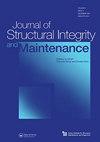碳纳米管增强树脂加固海上复合风叶片粘接接头的新概念
IF 3.1
Q2 ENGINEERING, CIVIL
Journal of Structural Integrity and Maintenance
Pub Date : 2020-04-02
DOI:10.1080/24705314.2020.1729519
引用次数: 9
摘要
海上风电叶片长度过大(bbb100 m)是风力发电机组的关键部件,因为其两部分的粘接是整体的,在风力发电机组运行过程中可能会导致叶片边缘突然分离。海上风力发电维护团队的目标是零维护。事实上,在发生机械损伤的情况下,风力叶片的顶部和底部外壳应该尽可能长时间地保持在一起,以便有足够的时间进行维护。我们提出了一个创新的概念,即采用两步策略,首先用碳纳米管(CNTs)加强键合接头,然后用复合材料绳将两个键合接头拼接起来。值得注意的是,碳纳米管既可以加强风叶片的两半,也可以在固化前添加在预浸料复合材料层之间,以提高粘合刚度。提出了一个有限元模型,其中模拟考虑了碳纳米管重量分数、手性和碳纳米管倾角与机械载荷的关系等参数。更高的接头刚度和更高的复合材料分层强度,期望在概念之外。这篇文章的目的是一个初步的数值研究,必须被视为一个概念的证明。本文章由计算机程序翻译,如有差异,请以英文原文为准。
Stiffening offshore composite wind-blades bonding joints by carbon nanotubes reinforced resin – a new concept
ABSTRACT Offshore wind-blades with excessive lengths (>100 m) are critical parts because of monolithic bonding that is holding the two halves, which may lead to sudden separation of edges while wind-turbine is in service. Offshore wind generation maintenance teams are targeting zero-maintenance. As a matter of fact, in the event of initiating mechanical damage, top and bottom skins of a wind blade should hold together as long as possible to allow enough time for maintenance to take place. We suggest an innovative concept that is a two-step strategy which consists first in strengthening the bond joints with carbon-nanotubes (CNTs), that be followed by a stitching of the two bonded joints with a composite cord. It is worthwhile to note that CNT can either reinforce the two halves of wind-blades and/or be added in between the pre-pregs composite plies before curing, to enhance bonding stiffness. A Finite Element model is proposed where simulation takes into account parameters such as CNT-weight fraction, chirality and CNTs inclination versus mechanical loading. Higher stiffness of joints and higher delamination strength for composites, are expected out of the concept. This article is intended to be a preliminary numerical study that must be viewed as a proof of concept.
求助全文
通过发布文献求助,成功后即可免费获取论文全文。
去求助
来源期刊

Journal of Structural Integrity and Maintenance
ENGINEERING, CIVIL-
CiteScore
3.90
自引率
9.50%
发文量
24
 求助内容:
求助内容: 应助结果提醒方式:
应助结果提醒方式:


